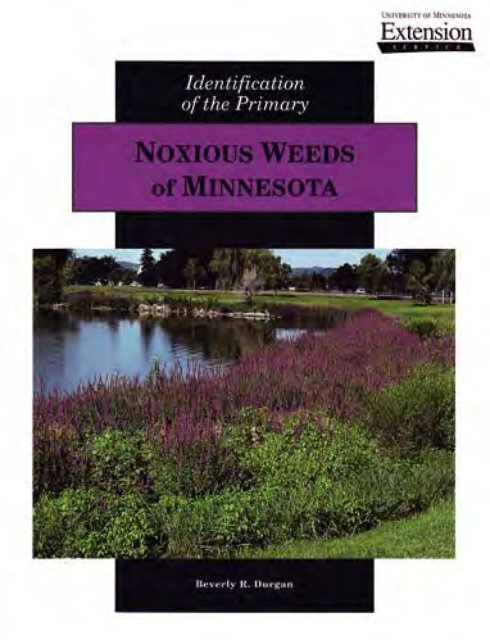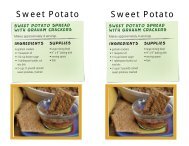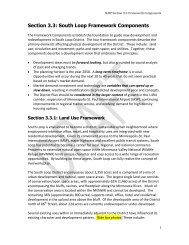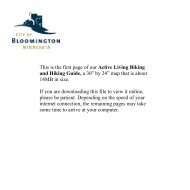Identification of the Primary Noxious Weeds of Minnesota - City of ...
Identification of the Primary Noxious Weeds of Minnesota - City of ...
Identification of the Primary Noxious Weeds of Minnesota - City of ...
You also want an ePaper? Increase the reach of your titles
YUMPU automatically turns print PDFs into web optimized ePapers that Google loves.
Extension
MINNESOTA NOXIOUS WEED LAWThe <strong>Minnesota</strong> <strong>Noxious</strong> Weed Law was enacted to protect <strong>the</strong> residents <strong>of</strong><strong>Minnesota</strong>from injurious effects <strong>of</strong> noxious weeds to public health, public roads, environment,crops, livestock, and o<strong>the</strong>r property. This law and related statutes areunder <strong>the</strong> general administration <strong>of</strong> <strong>the</strong> Commissioner <strong>of</strong> <strong>the</strong> <strong>Minnesota</strong> Department<strong>of</strong> Agriculture. Day-to-day or routine administration <strong>of</strong> <strong>the</strong> state's noxiousweed control program is carried out by <strong>the</strong> Director <strong>of</strong> <strong>the</strong> Agronomy ServicesDivision through <strong>the</strong> Supervisor <strong>of</strong> <strong>the</strong> Section <strong>of</strong> Weed Control. Implementation<strong>of</strong> <strong>the</strong> noxious weed law is accomplished through several Regulatory Investigatorslocated throughout <strong>the</strong> state. One <strong>of</strong> <strong>the</strong>ir primary duties is to see that localgovernments fulfill <strong>the</strong>ir responsibilities in <strong>the</strong> actual enforcement <strong>of</strong><strong>the</strong> law. Theactual enforcement is carried out by local governments through local weed inspectorsin townships and cities and County Agricultural Inspectors in every <strong>Minnesota</strong>county.A noxious weed, as defined by <strong>Minnesota</strong> Law, is an annual, biennial, or perennialwhich is deemed by <strong>the</strong> Commissioner <strong>of</strong>Agriculture to be injurious to publichealth, public roads, environment, crops, livestock, and o<strong>the</strong>r property. In <strong>Minnesota</strong>,<strong>the</strong>re are ten weeds on <strong>the</strong> primary noxious weeds list. They are:Common NameBindweed, fieldHempIvy, poisonLoosestrife, purpleSpurge, leafySowthistle, perennialThistle, bullThistle, CanadaThistle, muskThistle, plumelessGenus and speciesConvolvulus arvensisCannabis sativaToxicodendron radicansLythrum salicaria, virgatum, orany combinationEuphorbia esulaSonchus arvensisCirsium vulgareCirsium arvenseCarduus nutansCarduus acanthoidesAccording to <strong>Minnesota</strong> law, <strong>the</strong>se primary noxious weeds must be controlled onall private and public land in <strong>the</strong> state.2
INTRODUCTIONThis publicationwill be limited to <strong>the</strong> identification <strong>of</strong> <strong>the</strong> ten primary noxious weeds on<strong>the</strong> primary noxiousweed list in <strong>Minnesota</strong>. This list includes six perennial, three biennial, and one annual weed.Annual weeds germinate and emerge from seed and complete <strong>the</strong>ir life cycle in one growing season. Annualweeds that complete <strong>the</strong>ir life cycle during <strong>the</strong> periodfrom springto fall are called summerannuals or justannuals.Annual weeds that complete <strong>the</strong>ir life cycle during <strong>the</strong> period from fall to spring are called winter annuals.There is only one annual weed on <strong>the</strong> <strong>Minnesota</strong> <strong>Noxious</strong> Weed list--hemp.Biennial weeds require two growing seasons to complete <strong>the</strong>ir life cycle. Biennials form a rosette (clusters <strong>of</strong>leaves close to <strong>the</strong> ground) <strong>the</strong> first year and during <strong>the</strong> second year <strong>the</strong>y develop a flower stalk, flower, produceseed, and <strong>the</strong>n <strong>the</strong> plant dies. The three biennial weeds on <strong>the</strong> <strong>Minnesota</strong> <strong>Noxious</strong> Weed list are: bullthistle, musk thistle, and plumeless thistle.A perennial weed can live for 3 or more years. Perennial weeds may emerge from seed like annuals and biennials,but also emerge from rhizomes, stolons, or o<strong>the</strong>r underground storage organs. The six perennial weedson<strong>the</strong> <strong>Minnesota</strong> <strong>Noxious</strong>Weedlist are: field bindweed,purpleloosestrife, poisonivy, leafy spurge, perennialsowthistle, Canada thistle.TABLE OF CONTENTS<strong>Minnesota</strong> <strong>Noxious</strong> Weed La''''' 2Introduction 3Glossary 14Additional References 14Secondary <strong>Noxious</strong> <strong>Weeds</strong> 15PRIMARY NOXIOUS WEEDSCommon NameGenus and SpeciesAnnual <strong>Weeds</strong>HempCannabis sativa 4Biennial <strong>Weeds</strong>Bull ThistleMusk ThistlePlumelessThistleCirsium vulgare 5Carduus nutans 6Carduus acanthoides 7Perennial <strong>Weeds</strong>Canada ThistleField BindweedLeafy SpurgePerennial SowthistlePoison IvyPurple LoosestrifeCirsium arvensis 8Convolvulus arvensis 9Euphorbia esula 10Sonchus arvensis 11Toxicodendron radicans 12Lythrum salicaria, virgatum 133
BULL THISTLE[Cirsium vulgare (Savi) Tenore]COMPOSITE FAMILY - CompositaeDescription: Bull thistle growsmost<strong>of</strong>tenas a biennial,reproducingonlybyseed. During<strong>the</strong>firstyear <strong>of</strong> growth, a large basal rosette with a largetap root is formed. During <strong>the</strong> second year <strong>of</strong>growth, anerectflowering stem grows to a heightDf 2 to 4 feet. The stem is large, branched, and:overedwith dense hair. Leaf bases extend down<strong>the</strong> stem to give <strong>the</strong> stem a winged appearance.The leaves are alternate, dark green, coarsely lobed,with 3 to 4 points per lobe, each ending in a longsharp spine. The upper surface <strong>of</strong> <strong>the</strong> leaf is:overed with short, stiff hairs and spines, and <strong>the</strong>underside <strong>of</strong> <strong>the</strong> leaf is covered with dense, woolly,gray hair. The flower heads are compact, 1 to 2inches in diameter and each flower head is surroundedby spine-tipped bracts. The flowers arereddish-purple. Flowering occurs from late Junethrough August and <strong>the</strong> seed matures in Julythrough September. The seeds are 1/8 inch long,Dblong, flattened, and curved and are light brownwith dark brown stripes.Distribution: Bull thistle is primarily found inpastures, waste areas, and along roadsides. Bullthistle is found throughout <strong>Minnesota</strong> and canbefound on a variety <strong>of</strong> soil types.SeedlingLeafMature PlantSeed5
MUSK THISTLE(Carduus nutans L.)COMPOSITE FAMILY - CompositaeDescription: Musk thistle (also called noddingthistle) reproduces only by seed and grows most<strong>of</strong>ten as a biennial; however, it can occasionallygrow as a winter annual or annual. During <strong>the</strong>first year <strong>of</strong> growth, a large basal rosette with alarge tap rootisformed. During<strong>the</strong> secondyear<strong>of</strong>growth, anerect flowering stem grows to a height<strong>of</strong> 3 to 6 feet. The stem is branched with spinyleaves extending down <strong>the</strong> stem to give it a wingedappearance The wings are lobed and wavy wi<strong>the</strong>ach lobe ending in a spine. The leaves are darkbluish-green with light green midribs and have awhite margin. The-
PLUMELESS THISTLE(Carduus acanthoides L.)COMPOSITE FAMILY-CompositaeDescription: Plumeless thistle reproduces onlyby seed and grows most <strong>of</strong>ten as a biennial;however, it can occasionally grow as a winterannualorannual. During<strong>the</strong> first year<strong>of</strong>growth,a large basal rosette with a large tap root is formed.During <strong>the</strong> second year <strong>of</strong> growth, an erect floweringstem grows to a height <strong>of</strong> 3 to 6 feet. Thestemis branched and has spinywings. Theleavesare alternate, narrow, deeply lobed, have scatteredhair on <strong>the</strong> upper leaf surface, and densewhite hair on <strong>the</strong> lower surface, especially along<strong>the</strong> midrib. Lobes on <strong>the</strong> leaves and stem, end inwhite to yellowish spines. The flower heads areglobe-shaped, erect, single or loosely clustered,with spiny bracts at <strong>the</strong> base <strong>of</strong>eachflower head.The flower heads are reddish-purple and1/2to 1inch in diameter. Flowering occurs from JunethroughAugust,withseedsmaturing5 to12daysafterfull bloom. Theseedsarestraw-coloredwithbrownstriations to <strong>the</strong>collarwhere <strong>the</strong> pappus isattached. The seeds are 1/16 inch in length, usuallylinear but occasionally curved.Distribution: Plumeless thistle is primarily foundin pastures, waste areas, and along roadsides. Itprefers sandy, well-drained soils. Plumeless thistleis found throughout <strong>Minnesota</strong>.SeedlingLeafMature PlantSeed7
SeedlingLeafCANADA THISTLE(Cirsium arvense L.)COMPOSITE FAMILY - CompositaeDescription: Canada thistle is a perennial reproducingby seeds and underground roots. Theroots extend severalfeet deep and some distancehorizontally, <strong>of</strong>ten forming dense patches. Themature plantwill reacha height<strong>of</strong>2 to 5 feet. Theupright stems are grooved, slightly hairy whenyoung, increasingly hairy as <strong>the</strong>y mature, andbranched at <strong>the</strong> top. The leaves are alternate,have crinkled edges, spiny margins, and are somewhatlobed. The flower heads are numerous,compact, and 3/4 inch or less in diameter. Theflowers are reddish-purple to purple and are surroundedby bracts without spiny tips. Male andfemale flowers are usually borne on separateplants. Flowering occurs from June throughoutSeptember with seed maturing 8 to 12 days afterfull bloom. The seeds are gray to brown, smooth,slightly tapered, 3/16inchlong, and have a ridgearound <strong>the</strong> blossom end.Distribution: Canada thistle can be found in allcrops, pastures, waste areas, and alongroadsidesthroughout<strong>Minnesota</strong>. Canadathistle is <strong>the</strong>mostprevalent and persistent broadleaf weed in <strong>the</strong>state.Mature PlantSeed8
FIELD BINDWEED(Convolvulus arvensis L.)MORNING GLORY FAMILY ConvolvulaceaeDescription: Field bindweed (also called creepingjenny or morningglory) is a perennial reproducingbybothseedsandundergroundroots.Theroot system is very extensive and may penetrate<strong>the</strong> soil to a depth<strong>of</strong>20 to 30 feet. The plant growsprostate or will climb on any nearby object. Thespreading stems are smooth, slender, usually twining,and may reach lengths <strong>of</strong> 2 to 7 feet on amature plant. The leaves are alternate with smoothmargins, and are arrow-shaped with two basallobes. The flowers are white to pink, approximately1 inchin diameter, funnel shaped, and areborne singly on long stalks in <strong>the</strong> axil <strong>of</strong> <strong>the</strong> leaf.The flower stalk has 2 bracts located 1/2 to 2inches below <strong>the</strong> flower, which helps to distinguishthis weed from hedge bindweed. Floweringoccurs from May to September. The seeds areborne in seed pods that are egg-shaped and containfour seeds. The seeds are dark brownishgray,1/8 inch long, have a roughened surface,and have one rounded and two flattened sides.Distribution: Field bindweed will grow in mostcultivatedfields, gardens, lawns,wasteareas, andalong roadsides. Field bindweed is found throughout<strong>Minnesota</strong>, with <strong>the</strong> heaviest infestations in<strong>the</strong> west~rn half <strong>of</strong> <strong>the</strong> state.SeedlingLeafMature PlantSeed9
LEAFY SPURGE(Euphorbia esula L.)SPURGE FAMILY - EuphorbiaceaeSeedlingFlowerDescription: Leafy spurge is a perennial that reproducesfrom both seeds and underground roots.The root system <strong>of</strong> leafy spurge is extensive andconsists <strong>of</strong>numerous coarse and fine roots whichoccupy a large volume <strong>of</strong> soil. Roots are mostabundantin<strong>the</strong>upperfoot <strong>of</strong>soil; however, somerootscanextend to a depth<strong>of</strong>15 feet ormore. Themature plantwill reach a height <strong>of</strong> 2 to 3 feet. Thestems are smooth, branched at <strong>the</strong> top, and containa milky juice (latex). The leaves are bluishgreen,linear shaped, narrow (1/4 inch wide)with smooth margins, and are alternate. Leafyspurge produces a flat-topped cluster <strong>of</strong> yellowishgreenflower-like structures called bracts onwhich<strong>the</strong> true flowers are produced. Flowering occursfrom June through August and seeds are producedfrom July to September. The seeds areborneinseedpodswhichare3-lobed andcontain3 seeds. Theseeds are gray-white to gray-brown,usually mottled or flecked with brown, 1/8 inchin length, smooth, and on one side <strong>the</strong>re is a faintdark seam that runs <strong>the</strong> length <strong>of</strong> <strong>the</strong> seed.Distribution: Leafy spurge grows primarily inpastures,wasteareas, andalongroadsides. Leafyspurge can be found throughout <strong>Minnesota</strong>.Heaviest infestations are found in <strong>the</strong> westernhalf<strong>of</strong><strong>the</strong>stateandalongmost<strong>of</strong><strong>the</strong>roadsidesin<strong>Minnesota</strong>'s metropolitan areas.Mature PlantSeed10
PERENNIAL SOWTHISTLE(Sonchus arvensis L.)COMPOSITE FAMILY - CompositaeDescription: Perennial sowthistle is a perennialreproducing by seed and underground roots. Rootscan penetrate <strong>the</strong> soil to a depth <strong>of</strong> several feet.The mature plant will reach a height <strong>of</strong>3 to 7 feet.The upright stems are smooth, with or withouthair, and contain a milky juice (latex). The leavesarevariable inshapeandsize. Thebasalleaves arenarrow and deeply lobed. The leaves along <strong>the</strong>stem are 4 to 8 inches long, alternate and attacheddirectly to <strong>the</strong> stem, irregularly too<strong>the</strong>d, lobed,with spiny edges. Flower heads are approximately1 1/2 inches in diameter, produced inclusters, bright yellow, and attached to terminalbranches at <strong>the</strong> top <strong>of</strong> <strong>the</strong> plant. Flowering occursin June through August and seeds mature inJulythrough September. The seeds are reddish-brown,1/8 inch in length, slightly flattened, longitudinallyribbedwith5 to 7ribs and havesmallercrosswrinkles.Distribution: Perennial sowthistle will grow incultivated fields, pastures, waste areas, and alongroadsides. Perennialsowthistleis found throughout<strong>Minnesota</strong> with <strong>the</strong> heaviest infestations foundin <strong>the</strong> western and nor<strong>the</strong>rn half <strong>of</strong> <strong>the</strong> state.SeedlingFlowerMature PlantSeed11
POISON IW[Toxicodendron radicans (L.) Kuntze]CASHEW FAMILY-AnacardiaceaeSeedDescription: Poison ivy is a native perennialwoodyspecies thatreproducesbybothseedsandunderground roots. Poison ivy primarily growsas a woody vine; however, if it is growing in fullsunlight it may grow as a shrubup to several feettall. As a vine, poison ivy will climb fence posts,shrubs, and trees. Older vines may be more than2 inches in diameter and may grow up to 75 feetin length. The leaves are alternate and consist <strong>of</strong>3 leaflets which can vary greatly in shape. Most<strong>of</strong>ten <strong>the</strong> leaflets are 2 to 4 inches in length,pointed at <strong>the</strong> tip, shiny, and have notched orsmooth edges. The leaves are petiolate and <strong>of</strong>ten<strong>the</strong> terminal leaflet has <strong>the</strong> longest stem. Theflowers areyellowish-green, small, 5petaled, andborne in a cluster 1 to 3 inches long. Floweringoccurs from August through September. Not allplants will flower or bear fruit. The seeds areproduced inside a fruit which grows in clustersonslenderstemsin<strong>the</strong>axil <strong>of</strong><strong>the</strong>leaves. Thefruitis grayish-white to yellow, 3/16 inchin diameterand has distinct lines marking <strong>the</strong> outer surface,somewhat like a peeled orange. The seeds aregrayish striped and approximately 1/8 inch indiameter.All parts <strong>of</strong> this plant contain a poisonous materialwhich causes blistering <strong>of</strong> <strong>the</strong> skin.Distribution: Poison ivy grows along streambanks, edges <strong>of</strong> paths and roadsides, fencerows,woodlands, and o<strong>the</strong>r noncultivated sites. Poisonivy prefers moist, shaded locations. Poisonivy is found throughout <strong>Minnesota</strong>, with <strong>the</strong>heaviest infestations found in wooded areas <strong>of</strong><strong>the</strong> state.Fall Foliage12
PURPLE LOOSESTRIFE(Lythrum salicaria L.)and (Lvthrum virgatum L.)LOOSESTRIFE FAMILY-LythraceaeDescription: Purple loosestrife is an aquatic perennialthat reproduces by seed, underground roots,and can spread by sprouting from pieces broken<strong>of</strong>f <strong>the</strong>plant. Ithasa woodytaprootwitha fibrousroot system that forms a dense mat. The erectstems<strong>of</strong>a matureplantcanreach 7feet. The stemsare somewhatsquare,coveredwithfine hairs, andbranched. The leaves are opposite or whorled,linear shaped with smooth edges, hairy, and attacheddirectly to <strong>the</strong> stem. The flowers are indense terminal spikes at <strong>the</strong> top <strong>of</strong> <strong>the</strong> plant.Flowers are purple-magenta with 5 to 7 petals.Flowering begins in June and continues throughearly September. The seeds are produced in seedpods that contain many seeds. The seeds are flat,light tan to goldenbrown, and very tiny (400 x 200microns), about<strong>the</strong>size <strong>of</strong>a tip <strong>of</strong>a pin. Eachplantcanproduce120,000 to2.7millionseedsina singlegrowing season.Distribution: Purple loosestrife is an aquaticplant that grows in wet soils in wet meadows,pasture wetlands, cattail marshes, streams andriverbanks, lakeshoresand ditches. Purpleloosestrifeinfestations are increasing in <strong>Minnesota</strong>.Currently, purple loosestrife has been identifiedin more than 75 percent <strong>of</strong> <strong>Minnesota</strong>'s counties.SeedlingFlowerMature PlantSeed13
GLOSSARYalternate leaves: leaves attached singly along a stem.annual: a plant that completes its life cycle in one year or less, and reproduces only by seed.axil: point where a leaf or branch is attached to <strong>the</strong> stem.biennial: a plant that completes its life cycle in 2 years, and reproduces only by seed.bract: a modified leaf structure that surrounds <strong>the</strong> flower on some plants.leaflet: a division <strong>of</strong> <strong>the</strong> leaf.lobe: <strong>the</strong> leaf margin that is shallowly or deeply divided into sections or divisions.opposite leaves: leaves attached in pairs along <strong>the</strong> stem.pappus: a cluster <strong>of</strong> fine hairs attached to <strong>the</strong> seed in some plants, e.g., dandelion.perennial: a plant that lives for more than 2 years, and reproduces by seeds, rhizomes, oro<strong>the</strong>r underground plant parts.rhizome: an underground creeping stem which provides <strong>the</strong> means <strong>of</strong> production <strong>of</strong> someperennial plants.rosette: a basal cluster <strong>of</strong> leaves. The first year's growth <strong>of</strong> biennial plants.stolon: an above-ground prostrate stem which provides <strong>the</strong> means <strong>of</strong> reproduction <strong>of</strong> someperennial plants.whorled leaves: three or more leaves attached at <strong>the</strong> same point along a stem.winter annual: an annual plant that initiates growth in <strong>the</strong> fall and produces seed <strong>the</strong> followingspring.winged: any membranous extension or in some instance <strong>the</strong> extension <strong>of</strong> <strong>the</strong> leaf blade.ADDITIONAL REFERENCESThe following references on weed identification are available from <strong>the</strong>University <strong>of</strong> <strong>Minnesota</strong> Extension ServiceNumberMI-1350MI-1349MI-1351MI-1352MI-2384MI-2228FO-0776TitleAnnual Broadleaf Weed <strong>Identification</strong>Annual Broadleaf Weed Seedling <strong>Identification</strong>Annual Grass and Perennial Weed Seedling <strong>Identification</strong>Annual Grass and Perennial Weed <strong>Identification</strong>Weed Seedling <strong>Identification</strong>: Annual BroadleavesWeed Seedling <strong>Identification</strong>: GrassesWeed Seedling <strong>Identification</strong>Check prices and orderfrom:University <strong>of</strong> <strong>Minnesota</strong> Extension ServiceDistribution CenterRoom 3 C<strong>of</strong>fey Hall1420 Eckles Ave.St. Paul, MN 55108612-625-8173Beverly R. Durgan is an extension agronomist, University <strong>of</strong><strong>Minnesota</strong> Extension ServiceCopy Editor: Mary Kay O'Hearn Graphic Design: Tracey J. Benson14
In addition to <strong>the</strong> ten primary noxious weeds, <strong>the</strong> <strong>Minnesota</strong> <strong>Noxious</strong> Weed Law also defines and lists 49 secondary noxious weeds.A county may select a weed or weeds from this secondary list to be placed on its noxious weeds list. Ifa secondary noxious weed isplaced on a county noxious weed list, that weed must be controlled in that county. The secondary noxious weeds are:Common NameAlyssum, hoaryArtichoke, JerusalemBuckwheat, wildBuffaloburBurdockButtercup, tallBrackenfernCarrot, wildCatchfly, nightfloweringCockle, whiteCocklebur, commonDaisy, oxeyeDock, curlyFlixweedFoxtail, giantGumweedHawksbeard, narrowleafHawksbeard, smoothHawkweed, orangeJimsonweedKnapweed, spottedKochiaLambsquarters, commonMallow, veniceMarshelderMilkweed, commonMuhly, wiresternMustard, wildNightshade, eastern blackNutsedge, yellow (nutgrass)Oat, wildPanicum, fallPanicum, wild proso milletPigweed, redrootPigweed, prostrateQuackgrassRadish, wildRagweed, commonRagweed, giantSandbur, fieldSmartweed, PennsylvaniaSmartweed, (ladysthumb)Sorghum-almumSunflower, common (except cultivars)TansyVelvetleafYellow rocketWoolly cupgrassWormwood, absinthGenus and speciesBerteroa incanaHelianthus tuberosusPolygonum convolvulusSolanum rostratumArctium minusRanunculus acrisPteridium aquilinumDaucus carotaSilene noctifloraLychnis albaXanthium pensylvanicumChrysan<strong>the</strong>mum leucan<strong>the</strong>mumRumex crispusDescurainia sophiaSeteria faberiiGrindelia squarossaCrepis tectorumCrepis capillarisHieracium aurantiacumDatura stramoniumCentaurea maculosaKochia scopariaChenopodium albumHibiscus trionumIva xanthifoliaAsclepias syriacaMuhlenbergia frondosaBrassica kaberSolanum nigrumCyperus esculentusAvenafatuaPanicum dichotomiflorumPanicum miliaceumAmaranthus retr<strong>of</strong>lexusAmaranthus blitoidesAgropyron repensRaphanus raphanistrumAmbrosia artemisiifoliaAmbrosia trifidaCenchrus pauciflorusPolygonum pensylvanicumPolygonum persicariaSorghum almumHelianthus annuusTanacetum vulgareAbutilon <strong>the</strong>ophrastiBarbarea vulgarisEriochloa villosaArtemisia absinthiumAdditional information on <strong>the</strong> laws governing, and on <strong>the</strong> enforcement <strong>of</strong> <strong>the</strong> noxious weed law can be obtained from:<strong>Minnesota</strong> Department <strong>of</strong>Agriculture, Agronomy Division Section <strong>of</strong>Weed Control,90 West Plate Boulevard, St. Paul, MN 55107 Phone: 612-296-612315
FO-5620-SReviewed 1998www.extension.umn.eduCopyright © 1998, Regents <strong>of</strong> <strong>the</strong> University <strong>of</strong> <strong>Minnesota</strong>. All rights reserved.For ordering information call 612-625-8173.Produced by Communication and Educational Technology Services, University <strong>of</strong> <strong>Minnesota</strong> Extension Service.The information given in this publication is for educational purposes only. References to commercial products or trade names is made with<strong>the</strong> understanding that no discrimination is intended and no endorsement by <strong>the</strong> University <strong>of</strong> <strong>Minnesota</strong> Extension Service is impliedFor Americans with Disabilities Act accommodations, please call (612) 625-8173.The University <strong>of</strong> <strong>Minnesota</strong> Extension Service is an equal opportunity educator and employer.Printed on recycled paper with minimum 10% postconsumer waste.







